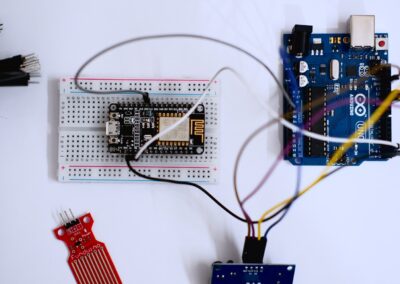Addressing the Risks of Unpatched IoT Devices
The Critical Importance of IoT Security Patches
IoT security patches are essential to protect devices from known exploits and vulnerabilities. In regions like Saudi Arabia and the UAE, where cities such as Riyadh and Dubai are at the forefront of technological advancements, ensuring the security of IoT devices is paramount. The absence of timely security patches in IoT firmware can leave devices exposed to cyberattacks, compromising the integrity and reliability of entire systems.
IoT devices are often deployed in large numbers, creating extensive networks that collect and transmit data. Without regular updates and security patches, these devices become prime targets for hackers who exploit known vulnerabilities. For example, an unpatched IoT device in a smart home system can be hijacked to gain unauthorized access to personal data or control other connected devices. In Riyadh, where smart city initiatives rely on interconnected IoT systems, the consequences of such breaches can be severe, affecting public safety and infrastructure.
Moreover, unpatched IoT devices can serve as entry points for broader cyberattacks. Cybercriminals can exploit vulnerabilities in these devices to infiltrate larger networks, spreading malware and disrupting operations. This risk is particularly significant in sectors such as healthcare and energy, where IoT devices play critical roles. In Dubai, ensuring the security of IoT devices in hospitals and energy grids is crucial to maintaining operational stability and protecting sensitive information.
Strategies for Ensuring Timely Patching
To mitigate the risks associated with unpatched IoT devices, organizations must implement robust strategies for timely firmware patching. One effective approach is to establish a comprehensive patch management policy that outlines the procedures for identifying, testing, and deploying security patches. This policy should include regular vulnerability assessments to identify potential risks and ensure that all IoT devices are up to date.
Automated patch management systems can significantly enhance the efficiency of the patching process. These systems can detect available updates, test them in controlled environments, and deploy them across the network with minimal manual intervention. In Saudi Arabia, businesses can leverage automated patch management solutions to ensure that their IoT devices remain secure and compliant with industry standards. For instance, in Riyadh’s smart transportation systems, automated patch management can ensure that all connected vehicles and infrastructure components receive timely updates, reducing the risk of cyberattacks.
Collaboration with IoT device manufacturers is another critical strategy. Organizations should work closely with vendors to ensure that security patches are developed and released promptly. Establishing clear communication channels with manufacturers can facilitate the rapid dissemination of updates and enable organizations to respond quickly to emerging threats. In Dubai, where IoT devices are widely used in public safety and security systems, collaboration with manufacturers is essential to maintain the integrity of these critical infrastructures.
Case Studies: Successful Implementation of IoT Security Patches
Several organizations in Saudi Arabia and the UAE have successfully implemented strategies for timely IoT security patches, demonstrating the effectiveness of these measures. For example, a healthcare provider in Dubai deployed an automated patch management system to secure its network of IoT-enabled medical devices. This system continuously monitors for vulnerabilities and deploys patches as soon as they become available, ensuring that all devices remain secure. As a result, the healthcare provider has significantly reduced the risk of cyberattacks and improved patient data protection.
In Riyadh, a smart city project implemented a comprehensive patch management policy to secure its IoT infrastructure. This policy includes regular vulnerability assessments, automated patch deployment, and collaboration with device manufacturers. By adhering to this policy, the project has maintained the security and reliability of its interconnected systems, enhancing public safety and operational efficiency. The success of this initiative highlights the importance of a proactive approach to IoT security.
Another notable example is a logistics company in the UAE that used automated patch management to secure its fleet of IoT-enabled vehicles. By ensuring that all devices receive timely updates, the company has improved the security of its operations and protected its data from cyber threats. This proactive approach has not only enhanced the company’s cybersecurity posture but also increased customer trust and satisfaction.
Future-Proofing IoT Security with Best Practices
Implementing Continuous Monitoring and Threat Intelligence
Continuous monitoring and threat intelligence are essential components of a robust IoT security strategy. By continuously monitoring IoT devices and networks, organizations can detect and respond to security incidents in real time. This proactive approach enables businesses to address vulnerabilities before they can be exploited, reducing the risk of cyberattacks. In regions like Saudi Arabia and the UAE, where IoT adoption is widespread, continuous monitoring is crucial for maintaining the security and reliability of connected systems.
Threat intelligence services provide valuable insights into emerging cyber threats and vulnerabilities. By leveraging these services, organizations can stay informed about the latest security risks and take proactive measures to protect their IoT devices. For example, a financial institution in Riyadh can use threat intelligence to identify potential threats to its IoT-enabled ATMs and implement security patches accordingly. This proactive approach ensures that the institution remains one step ahead of cybercriminals.
Moreover, integrating continuous monitoring with automated patch management systems can further enhance IoT security. These systems can automatically apply security patches based on real-time threat intelligence, ensuring that IoT devices are always protected against the latest threats. In Dubai, businesses can leverage this integration to secure their IoT networks and protect sensitive data from cyberattacks.
Enhancing Security Awareness and Training
Security awareness and training are critical components of an effective IoT security strategy. Organizations must educate their employees about the importance of IoT security and provide training on best practices for managing IoT devices. This training should cover topics such as recognizing phishing attacks, securing IoT devices, and adhering to patch management policies. In Saudi Arabia, where IoT adoption is growing rapidly, enhancing security awareness can significantly reduce the risk of human error and improve overall cybersecurity.
Regular training sessions and workshops can help employees stay informed about the latest security threats and best practices. By fostering a culture of security awareness, organizations can ensure that all employees play an active role in protecting IoT devices and networks. For example, a manufacturing company in Riyadh can conduct regular training sessions to educate its staff about the importance of timely IoT security patches and how to implement them effectively.
In addition to training, organizations should implement clear policies and procedures for IoT security. These policies should outline the roles and responsibilities of employees in managing IoT devices and ensure that everyone understands their role in maintaining security. In Dubai, businesses can develop comprehensive IoT security policies that cover all aspects of device management, from deployment to decommissioning, ensuring a consistent and secure approach to IoT integration.
Conclusion: The Path to Secure IoT Deployments
As IoT technology continues to evolve, ensuring the security of connected devices through timely firmware patching will remain a top priority for organizations. By implementing robust strategies for IoT security patches, businesses in Saudi Arabia and the UAE can protect their IoT systems from known exploits and vulnerabilities. Leveraging automated patch management systems, continuous monitoring, and threat intelligence, organizations can proactively address security risks and maintain the integrity of their IoT deployments.
In conclusion, IoT security patches are essential for protecting devices from cyber threats and ensuring the reliability of connected systems. By adopting best practices for patch management and enhancing security awareness, organizations can safeguard their IoT devices and networks. As the technological landscape continues to evolve, businesses that prioritize IoT security will be well-positioned to achieve long-term success and maintain a competitive edge in the digital age.
—
#IoTSecurityPatches #FirmwareVulnerabilities #TimelyPatching #Cybersecurity #IoTDevices #BusinessSuccess #ModernTechnology #LeadershipSkills #ProjectManagement #SaudiArabia #UAE #Riyadh #Dubai #ArtificialIntelligence #Blockchain #TheMetaverse #ExecutiveCoachingServices #GenerativeAI































